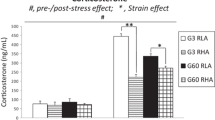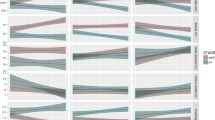Abstract
Maternal aggression is directed towards intruders by lactating females and is critical for defense of offspring. Within-family selection for increased maternal defense in outbred house mice (Mus domesticus; Hsd:ICR strain) was applied to one selected (S) line, using total duration of attacks in a 3-min test as the selection criterion. One control (C) line was maintained and both lines were propagated by 13 families in each generation. Prior to selection, heritability of maternal aggression was estimated to be 0.61 based on mother-offspring regression. Duration of attacks responded to selection with a mean realized heritability of 0.40 (corrected for within-family selection) after eight generations. At generation 5, the S and C line also differed significantly for litter size at birth and at mid-lactation (both lower in S), average individual pup mass at mid-lactation (higher in S), and pup retrieval latency (longer in S), but not for other maternal measures that we studied (e.g., dam mass). Additionally, number of entries to middle and closed plus maze compartments was significantly higher in S mice in Generation 5. This is the first study to select for high maternal defense and these mice will be made available as a tool for understanding the genetic and neural basis of maternal aggression.




Similar content being viewed by others
References
Agrell J, Wolff JO, Ylonen H (1998) Counter-strategies to infanticide in mammals: costs and consequences. Oikos 83:507–517
Anisman H, Zaharia MD, Meaney MJ, Merali Z (1998) Do early-life events permanently alter behavioral and hormonal responses to stressors? Int J Dev Neurosci 16:149–164
Benus RF (2001) Coping in female mice from lines bidirectionally selected for male aggression. Behaviour 138:997–1008
Bronikowski AM, Rhodes JS, Garland T Jr., Prolla TA, Awad TA, Gammie SC (2004) The evolution of gene expression in mouse hippocampus in response to selective breeding for increased locomotor activity. Evolution 58:2079–2086
Bult A, van der Zee EA, Compaan JC, Lynch CB (1992) Differences in the number of arginine-vasopressin-immunoreactive neurons exist in the suprachiasmatic nuclei of house mice selected for differences in nest-building behavior. Brain Res 578:335–338
Caldji C, Diorio J, Meaney MJ (2000a) Variations in maternal care in infancy regulate the development of stress reactivity. Biol Psychiatry 48:1164–1174
Caldji C, Francis D, Sharma S, Plotsky PM, Meaney MJ (2000b) The effects of early rearing environment on the development of GABAA and central benzodiazepine receptor levels and novelty-induced fearfulness in the rat. Neuropsychopharmacology 22:219–229
Caldji C, Tannenbaum B, Sharma S, Francis D, Plotsky PM, Meaney MJ (1998) Maternal care during infancy regulates the development of neural systems mediating the expression of fearfulness in the rat. Proc Natl Acad Sci US A95:5335–5340
Chiang CF, Johnson RK, Nielsen MK (2002) Selection for maternal behavior in mice – direct and correlated responses. Appl Anim Behav Sci 79:311–323
Clutter AC, Nielsen MK, Johnson RK (1990) Alternative methods of selection for litter size in mice. 1. Characterization of base-population and development of methods. J Anim Sci 68:3536–3542
D’Anna KD, Stevenson SA, Gammie SC (2005) Urocortin 1 and 3 impair maternal defense behavior in mice. Behav Neurosci:161–171
Del Punta K, Leinders-Zufall T, Rodriguez I, Jukam D, Wysocki CJ, Ogawa S, Zufall F, Mombaerts P (2002) Deficient pheromone responses in mice lacking a cluster of vomeronasal receptor genes. Nature 419:70–74
Falconer DS (1960) The genetics of litter size in mice. J Cell Comp Physiol 56 (Suppl. 1):153–167
Feldker DE, Datson NA, Veenema AH, Meulmeester E, de Kloet ER, Vreugdenhil E (2003a) Serial analysis of gene expression predicts structural differences in hippocampus of long attack latency and short attack latency mice. Eur J Neurosci 17:379–387
Feldker DE, Datson NA, Veenema AH, Proutski V, Lathouwers D, De Kloet ER, Vreugdenhil E (2003b) GeneChip analysis of hippocampal gene expression profiles of short- and long-attack-latency mice: technical and biological implications. J Neurosci Res 74:701–716
Francis DD, Young LJ, Meaney MJ, Insel TR (2002) Naturally occurring differences in maternal care are associated with the expression of oxytocin and vasopressin (V1a) receptors: gender differences. J Neuroendocrinol. 14:349–53
Friske JE, Gammie SC (2005) Environmental enrichment alters plus maze, but not maternal defense performance in mice. Physiol Behav 85:187–194
Gammie SC (2005) Current models and future directions for understanding the neural circuitries of maternal behaviors in rodents. Behav Cognitive Neurosci Rev 4:119–135
Gammie SC, Hasen NS, Rhodes JS, Girard I, Garland T Jr. (2003) Predatory aggression, but not maternal or intermale aggression, is associated with high voluntary wheel-running behavior in mice. Horm Behav 44:209–21
Gammie SC, Hasen NS, Stevenson SA, Bale TL, D’Anna K.D. (2005) Elevated stress sensitivity in corticotropin-releasing factor receptor 2 deficient mice decreases maternal, but not intermale aggression. Behav Brain Res 160:169–177
Gammie SC, Huang PL, Nelson RJ (2000) Maternal aggression in endothelial nitric oxide synthase-deficient mice. Horm. Behav. 38:13–20
Gammie SC, Negron A, Newman SM, Rhodes JS (2004) Corticotropin-releasing factor inhibits maternal aggression in mice. Behav. Neurosci. 118:805–814
Gammie SC, Nelson RJ (1999) Maternal aggression is reduced in neuronal nitric oxide synthase-deficient mice. J Neurosci 19:8027–8035
Gammie SC, Nelson RJ (2001) cFOS and pCREB activation and maternal aggression in mice. Brain Res 898:232–241
Girard I, Swallow JG, Carter PA, Koteja P, Rhodes JS, Garland T (2002) Maternal-care behavior and life-history traits in house mice (Mus domesticus) artificially selected for high voluntary wheel-running activity. Behav Processes 57:37–50
Hasen NS, Gammie SC (2005) Differential fos activation in virgin and lactating mice in response to an intruder. Physiol Behav 84:684–695
Holt M, Meuwissen T, Vangen O (2005) Long-term responses, changes in genetic variances and inbreeding depression from 122 generations of selection on increased litter size in mice. J Anim Breed Genet 122:199–209
Hood KE, Cairns RB (1988) A developmental-genetic analysis of aggressive behavior in mice. II. Cross-sex inheritance. Behav Genet 18:605–619
Hyde JS, Sawyer TF (1980) Selection for agonistic behavior in wild female mice. Behav Genet 10:349–359
Kinsley C, Svare B (1988) Prenatal stress alters maternal aggression in mice. Physiol Behav 42:7–13
Konarzewski M, Ksiazek A, Lapo IB (2005) Artificial selection on metabolic rates and related traits in rodents. Integr Comp Biol 45:416–425
Koskela E, Juutistenaho P, Mappes T, Oksanen TA (2000) Offspring defence in relation to litter size and age: experiment in the bank vole Clethrionomys glareolus. Evol Ecol. 14:99–109
Lonstein JS, Gammie SC (2002) Sensory, hormonal, and neural control of maternal aggression in laboratory rodents. Neurosci Biobehav Rev 26:869–888
Lynch CB (1980) Response to divergent selection for nesting behavior in Mus musculus. Genetics 96:757–765
Maestripieri D (1990) Maternal aggression and litter size in the female house mouse. Ethology 84:27–34
Maestripieri D, Badiani A, Puglisi-Allegra S (1991) Prepartal chronic stress increases anxiety and decreases aggression in lactating female mice. Behav Neurosci 105:663–668
Maestripieri D, D’Amato FR (1991) Anxiety and maternal aggression in house mice (Mus musculus): a look at interindividual variability. J Comp Psychol 105:295–301
Meek LR, Dittel PL, Sheehan MC, Chan JY, Kjolhaug SR (2001) Effects of stress during pregnancy on maternal behavior in mice. Physiol Behav 72:473–479
Mos J, Olivier B (1989) Quantitative and comparative analyses of pro-aggressive actions of benzodiazepines in maternal aggression of rats. Psychopharmacology (Berl) 97:152–153
Pardon M, Gerardin P, Joubert C, Perez-Diaz F, Cohen-Salmon C (2000) Influence of prepartum chronic ultramild stress on maternal pup care behavior in mice. Biol Psychiatry 47:858–863
Parmigiani S, Palanza P, Rogers J, Ferrari PF (1999) Selection, evolution of behavior and animal models in behavioral neuroscience. Neurosci Biobehav Rev 23:957–969
Peripato AC, De Brito RA, Vaughn TT, Pletscher LS, Matioli SR, Cheverud JM (2002) Quantitative trait loci for maternal performance for offspring survival in mice. Genetics 162:1341–1353
Rhees BK, Ernst CA, Miao CH, Atchley WR (1999) Uterine and postnatal maternal effects in mice selected for differential rate of early development. Genetics 153:905–917
Rodgers RJ, Dalvi A (1997) Anxiety, defence and the elevated plus-maze. Neurosci Biobehav Rev 21:801–810
Roy V, Belzung C, Delarue C, Chapillon P (2001) Environmental enrichment in BALB/c mice: effects in classical tests of anxiety and exposure to a predatory odor. Physiol Behav 74:313–320
Sandnabba NK (1993) Female aggression during gestation and lactation in two strains of mice selected for isolation-induced intermale aggression. Behavioural Processes 30:157–164
Sandnabba NK (1996) Selective breeding for isolation-induced intermale aggression in mice: associated responses and environmental influences. Behav Genet 26:477–488
Stowers L, Holy TE, Meister M, Dulac C, Koentges G (2002) Loss of sex discrimination and male-male aggression in mice deficient for TRP2. Science 295:1493–1500
Svare B (1990) Maternal aggression: hormonal, genetic, and developmental determinants. In: Krasnegor NA, Bridges RS (eds) Mammalian parenting: biochemical, neurobiological, and behavioral determinants. Oxford University Press, New York, pp 118–132
Svare B, Betteridge C, Katz D, Samuels O (1981) Some situational and experiential determinants of maternal aggression in mice. Physiol Behav 26:253–258
Svare B, Gandelman R (1973) Postpartum aggression in mice: experiential and environmental factors. Horm Behav 4:323–324
Swallow JG, Carter PA, Garland T Jr. (1998) Artificial selection for increased wheel-running behavior in house mice. Behav Genet 28:227–237
Swallow JG, Garland T (2005) Selection experiments as a tool in evolutionary and comparative physiology: Insights into complex traits – An introduction to the symposium. Integr Comp Biol 45:387–390
van Oortmerssen GA, Bakker TC (1981) Artificial selection for short and long attack latencies in wild Mus musculus domesticus. Behav Genet 11:115–126
Wall PM, Messier C (2001) Methodological and conceptual issues in the use of the elevated plus-maze as a psychological measurement instrument of animal anxiety-like behavior. Neurosci Biobehav Rev 25:275–286
Weiss SM, Wadsworth G, Fletcher A, Dourish CT (1998) Utility of ethological analysis to overcome locomotor confounds in elevated maze models of anxiety. Neurosci Biobehav Rev 23:265–271
Wolff JO (1985) Maternal aggression as a deterrent to infanticide in Peromyscus leucopus and P. maniculatus. Anim Behav 33:117–123
Wolff JO (1993) Why are female small mammals territorial. Oikos 68:364–370
Acknowledgments
This work was supported by National Institutes of Health Grant R01 MH066086 to S.C.G and by the University of Wisconsin Graduate School and Department of Zoology. The authors wish to thank Emily Bethea, Kelly Clinkenbeard, Kimberly D’Anna, Michael Foley, Nina Hasen, Allen Irgens, Patrick Klevin, Sruthi Swaminathan, and Lindsay Theis for technical assistance and Kate Skogen and Jeff Alexander for animal care. T.G. was supported by National Science Foundation grant IBN-0212567.
Author information
Authors and Affiliations
Corresponding author
Rights and permissions
About this article
Cite this article
Gammie, S.C., Garland, T. & Stevenson, S.A. Artificial Selection for Increased Maternal Defense Behavior in Mice. Behav Genet 36, 713–722 (2006). https://doi.org/10.1007/s10519-006-9071-x
Received:
Accepted:
Published:
Issue Date:
DOI: https://doi.org/10.1007/s10519-006-9071-x




